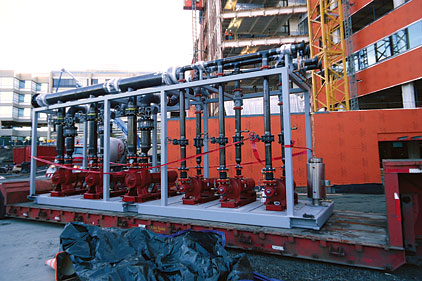
|
| McKinstry, a mechanical contractor in Seattle, prefabricated HVAC pump skids for Seattle Children’s Hospital. Five pump skids were delivered and rolled into place in the basement mechanical room. |
Yet the sector still provides opportunities for contractors who are willing to change their approach to assist facility managers and align their work with healthcare administrators’ business goals. In this uncertain environment, C-level hospital executives are applying pressure to cut costs, save energy, and do more with less. There are also trends toward performance-based rather than outcome-based facilities, and toward construction of diagnostic centers, surgical centers, and urgent care centers.
Shifts in Healthcare
The economic downturn has certainly had a negative impact on the entire commercial market. Todd Follis, senior project manager at JW Danforth, Tonawanda, N.Y., said, “There are a lot of contractors hungry for work, and plan and spec work is going out the door at three to five percent margins, so if you want to get the job here you are taking it for very little.”
The healthcare sector has also been facing the additional uncertainty that has surrounded the Patient Protection and Affordable Care Act (PPACA), commonly called Obamacare. Initially, there was a lot of confusion and even questions about the constitutionality of the legislation. Since the legislation was signed into law more than two years ago, the healthcare industry has identified some likely trends that will result.
Jerry Day, project director for the new construction and design group at McKinstry, said, “There will be a flood of new insured [patients] that will stress the infrastructure of our healthcare facilities, but there are a lot of people [in the healthcare industry] waiting on the sidelines to make those big capital expenditures.”
Under the PPACA law, there is also a shift in the way healthcare facilities are compensated by the insurance companies. Some reimbursement changes will push primary care outside of a hospital. There will be penalties for excessive hospital-acquired infection rates and penalties for 30-day re-admission rates.
“Doing it right the first time and keeping people out of the hospital and in primary care appears to be of benefit to the hospital,” Kelley said. “And it appears that is the direction that things are going. The hospital of the future will have fewer and fewer acute care beds as procedures are moved more and more to outpatient facilities.”
Outpatient facilities like surgical centers, urgent care facilities, imaging centers, and lab centers are much more economical to build and the quality of care can still remain high. According Michael Argir, executive vice president of ABM Health, a large facility management services provider, “The current state of the healthcare market is extremely reactionary to unknown circumstances. Our customers [healthcare facilities] are reacting to what they think will happen to healthcare reimbursement, so we are seeing a tightening of the belt, deferred maintenance, and changes in the market where services typically done within the hospital’s four walls are now being moved to offsite locations.”
Contractors as Partners
As the healthcare market changes, so does the relationship between the facility and the mechanical contractor. Facility managers are looking for more than just the low bid — they are also looking for a partnership.
“The mechanical contractor needs to provide competitive pricing, intimate knowledge of the building, strategies on how to become more efficient, and an understanding of what it takes to run a facility better so it improves patient care,” Argir said.
Contractors that plan to play in the healthcare market need to not only be extremely price competitive but also be prepared to execute with a qualified foreman and manage a complexity of systems that architects and engineers put together. According to Follis, “It’s a pretty elite crew that is required to install an A-class construction project.”
He also talked about attributes that facilities managers are looking for in a mechanical contractor. “They want to know that you have a pedigree in the healthcare construction world, and you can be a full-service solution provider in any part of the construction project.”
Construction Trends
Healthcare facilities are adjusting to market changes by being adaptive in their renovation projects. As a result, mechanical systems must be adaptive as parts of a facility expand or contract. Rooms or suites now must be multifunctional — and that means that ventilation and air conditioning needs must change.
Another area of concentration is the ability to create air changes in a hospital as quickly as possible. If systems can be designed and installed to go from six air changes per hour to 12 changes per hour, then patient rooms can be turned over much more quickly. Day and Follis talked about designing areas with a multiple fan array to have redundancy so if a fan goes down it doesn’t negatively impact multiple operating rooms.
As healthcare construction trends continue to evolve, contractors working in this sector must be willing and able to evolve with it.
Argir advised, “It’s changing rapidly. You must maintain a flexibility and a focus to build a performance-based relationship using measureable data to help you adapt quickly to the change when it comes.”
Sidebar: Facility Management
Dan Swanson, project director at McKinstry, recently issued a white paper on the healthcare industry titled, “Critical Actions for 2013 & Beyond.” In this document, Swanson suggests that everything related to a healthcare facility should shift from task-based management to outcome- and performance-based management. Swanson has over 30 years of direct facilities experience as the director of engineering, construction, and facilities for large healthcare campus-type complexes.
According to Swanson, facilities managers need to align their team with “executive-level goals of delivering high-performance results,” which he said will lead to “meaningful, quantifiable, and long lasting change to an entire system.”
Swanson’s white paper states that as the healthcare market is being driven toward quality and performance, the old delivery model of “pay for procedure” is no longer relevant. The new model is “pay for performance.” This puts increased importance on patient comfort in terms of temperature and noise control.
Also, healthcare facilities are pushing to maintain compliance standards while doing more with less. Because of this, facilities need to minimize extraneous preventive maintenance procedures. Overall, Swanson recommends that healthcare facilities should be run like a business, with decisions made after gathering appropriate data and assigning costs based on clinical impact.
Publication date: 10/29/2012









